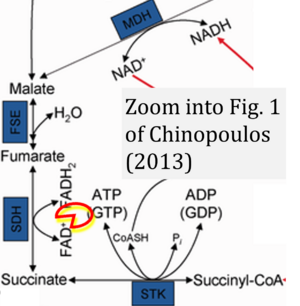Chinopoulos 2013 J Neurosci Res
| Chinopoulos C (2013) Which way does the citric acid cycle turn during hypoxia? The critical role of α-ketoglutarate dehydrogenase Complex. J Neurosci Res 91:1030-43. |
Chinopoulos Christos (2013) J Neurosci Res
Abstract: The citric acid cycle forms a major metabolic hub and as such it is involved in many disease states involving energetic imbalance. In spite of the fact that it is being branded as a "cycle", during hypoxia, when the electron transport chain does not oxidize reducing equivalents, segments of this metabolic pathway remain operational but exhibit opposing directionalities. This serves the purpose of harnessing high-energy phosphates through matrix substrate-level phosphorylation in the absence of oxidative phosphorylation. In this Mini-Review, these segments are appraised, pointing to the critical importance of the α-ketoglutarate dehydrogenase Complex dictating their directionalities.
• Keywords: TCA cycle
• Bioblast editor: Cardoso LHD
• O2k-Network Lab: HU Budapest Chinopoulos C
Comment: FAD is shown as FAD+ - possibly by copying from NAD+. But FAD is neither charged nor a co-substrate comparable to NAD+, but it is a covalently bound prosthetic group in CII (Gnaiger 2023 MitoFit CII).
Correction: FADH2 and Complex II
- FADH2 is shown as the substrate feeding electrons into Complex II (CII). This is wrong and requires correction - for details see Gnaiger (2024).
- Gnaiger E (2024) Complex II ambiguities ― FADH2 in the electron transfer system. J Biol Chem 300:105470. https://doi.org/10.1016/j.jbc.2023.105470 - »Bioblast link«
Labels:
Stress:Hypoxia
MitoFit2022rTCA


